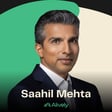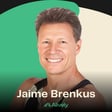
Breathing Techniques To Reduce Stress with Todd Steinberg - E53
Could the best way to calm your mind really be as simple as changing the way you breathe?
This episode explores how shifting from unconscious to intentional breathing can disrupt our tendencies to get stressed and have difficulty thinking clearly. We go into how such an accessible change can help lower stress hormones, restore mental clarity, and help you approach daily challenges with more resilience.
Todd Steinberg is the founder of Komuso, a company dedicated to practical stress management and mindfulness through breathwork. Formerly a high-performing entrepreneur driven by what he later identified as high-functioning anxiety, Todd shifted his approach after discovering simple breath techniques, an experience that became the basis for his company’s signature breathing necklace. Today, Steinberg’s tools are used by individuals seeking accessible solutions to stress, emphasizing simplicity in optimizing healthspans.
“When you're returning yourself to that state, you're able to again wash out the cortisol and then come back to just feeling good and okay.” - Todd Steinberg
In this episode you will learn:
- How high-performing anxiety can show up as constant drive and stress, and how Todd realized it was impacting his daily life and health.
- The science behind straw breathing and how simple, deliberate breathwork can reduce cortisol, support clearer thinking, and interrupt negative thought cycles.
- Practical breathing routines for different situations, including preventative breathing first thing in the morning and rescue breathing when stress hits.
- Why most of our daily thoughts are negative and repetitive, and how breath awareness offers a way to break unhelpful patterns.
- The connection between mouth versus nose breathing, physical performance, and long-term health, with easy experiments to try while exercising.
- How using physical cues like the Komuso necklace can help build the habit of mindful breathing and improve emotional resilience throughout the day.
Resources
- Connect with Todd on Instagram: https://www.instagram.com/todsky21
- Learn more about what Komuso has to offer: https://www.komusodesign.com/
- Shop all the products Todd mentions in this episode: https://alively.com/products/todd-steinberg
This podcast was produced by the team at Zapods Podcast Agency:
https://www.zapods.com
Find the products, practices, and routines discussed on the Alively website:
https://alively.com/



















